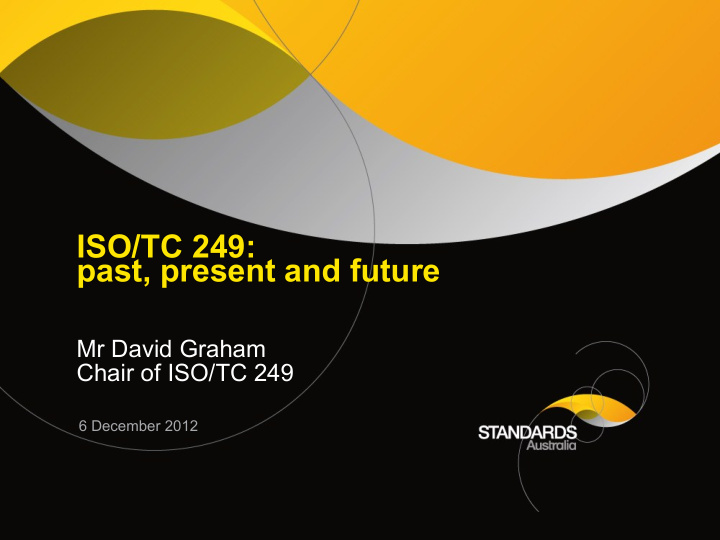



ISO/TC 249: past, present and future Mr David Graham Chair of ISO/TC 249 6 December 2012
THE PAST
History of ISO/TC proposed by SAC at 45 th TMB, ISO/TC 249 June 2009 Preliminary meeting August 2009, Beijing ISO/TC 249 approved at 46 th TMB, Sept 2009 1 st Plenary meeting, Beijing, June 2010 2 nd Plenary meeting, the Hague, May 2011 3 rd Plenary meeting, Daejeon, Korea, May 2012 4 th Plenary meeting, Durban, May 2013
Why the TCM is used in over 120 countries and the technical PRC wants to: committee protect the IP, standards and reputation was formed? of TCM support national and international trade and commerce protect public health and safety
What the TMB The TMB established ISO/TC 249 with the asked provisional title of ‘Traditional Chinese Medicine’ and asked whether other forms of Traditional Medicine can be accommodated
Supply chain for therapeutic products SUPPLIER PRACTITIONER PATIENT • devices • medicines • methodology QUALITY TRAINING RATIONAL USE SAFETY & EFFICACY PRACTICE INFORMATICS EVIDENCE BASE
Two dimensions of the scope 1. Scope of modalities (title) TCM TMs (one project) (multiple projects) 2. Each modality scope • Practitioner education and training • Quality and safety of products/services • Evidence base (efficacy) • Other: rational use, informatics
THE PRESENT
Modality scope of ISO/TC 249 Supply chain for therapeutic products SUPPLIER PRACTITIONER PATIENT • devices • medicines • methodology QUALITY TRAINING RATIONAL USE SAFETY & EFFICACY PRACTICE INFORMATICS EVIDENCE BASE
Scope of Still operating under the provisional title ISO/TC 249 of TCM (Title) Aspects of the work cover TCM and related TMs (Korean Medicine and Kampo)
Current Main Technical Committee structure of 5 Working Groups ISO/TC 249 WG 1: Quality and safety of raw materials and traditional processing WG 2: Quality and safety of manufactured products WG 3: Quality and safety of acupuncture needles WG 4: Quality and safety of other medical devices WG 5: Informatics of TCM One joint working group with ISO/TC 215 (health informatics)
Participants P (Participating Members) Korea, Republic of ( KATS) Australia ( SA ) Mongolia ( MASM ) Austria ( ASI ) Netherlands ( NEN ) Canada ( SCC ) Norway ( SN ) China (SAC) Singapore ( SPRING SG ) Finland ( SFS ) South Africa ( SABS ) France ( AFNOR ) Spain ( AENOR ) Germany ( DIN ) Switzerland ( SNV ) Ghana ( GSB ) Thailand ( TISI ) India ( BIS ) Tunisia ( INNORPI ) Israel ( SII ) USA ( ANSI ) Italy ( UNI ) Viet Nam ( STAMEQ ) Japan ( JISC ) (24)
O (Observer) members (8) Participants Barbados ( BNSI ) Hong Kong, China ( ITCHKSAR ) (Correspondent member) Ireland ( NSAI ) Lithuania ( LST ) New Zealand ( SNZ ) Poland ( PKN ) Sweden ( SIS ) United Kingdom ( BSI ) Liaison World Health Organization (WHO) organisations World Federation of Acupuncture and Moxibustion Societies (WFAS) World Federation of Chinese Medicine Societies (WFCMS)
Current Draft International Standards for : activities of ISO/TC 249 ISO17217 Ginseng seed and seedlings ISO17218 Sterile acupuncture needles for single use Working Drafts under development : • N40 Computerized tongue diagnosis system • N41 Requirements for basic safety and essential performance for electroacupuncture stimulator • N42 General requirements of electric radial pulse tonometric devices
Current Items under development: activities of N45 Heavy metals in natural materials of ISO/TC 249 TCM (continued) N47 Moxibustion devices N44 Quality requirements for electroacupuncture stimulator N46 Herbal decoction apparatus Intradermal acupuncture needle N43 Basic terms of Chinese Materia Medica N48 Coding system of Chinese Medicine
ISO/TC 249 Chair: Dr David GRAHAM Secretary: Prof SHEN Yuandong Assistant Secretary: Dr SANG Zhen Secretariat: Ivy Lee, Shirley Xu, Huang Yufeng Location: Shanghai Secretariat host: Standardization Administration of China (SAC)
THE FUTURE
Underlying We deal with internationally-used health principles modalities rather than those used solely guiding our within one country work Our outcomes are based on consensus and we optimise participation by stakeholders Sensitive to differing proficiencies between countries We create International standards that accommodate national adjustments Compliments rather than duplicates existing resources
Considerations A traditional medicine is a complementary medicine in other countries Modernisation of TMs through different formulations and methods of manufacture and presentation The need to put the issue over the committee’s Title behind us Ensuring the correct motives and need for new standards The deficiencies in the evidence base for TMs Effective engagement with WHO on informatics
Underpins the international use and The benefits acceptable practice of a health modality of an International Assists global consistency, e.g. practice, Standard terminology, common understanding Protects the reputation of the modality Assists in setting national standards Assists harmonisation, trade and information exchange Protects the community Assists acceptance and use of the health modality Supports integration within health care more generally
THANK YOU
Recommend
More recommend